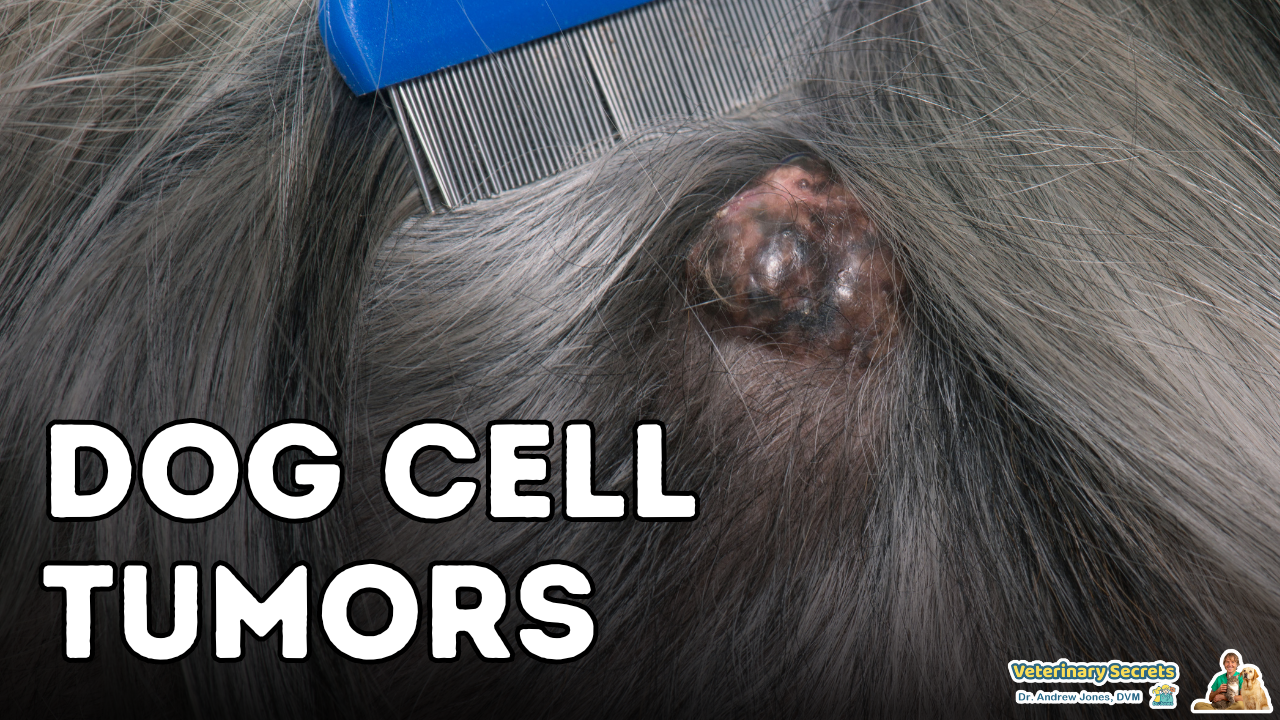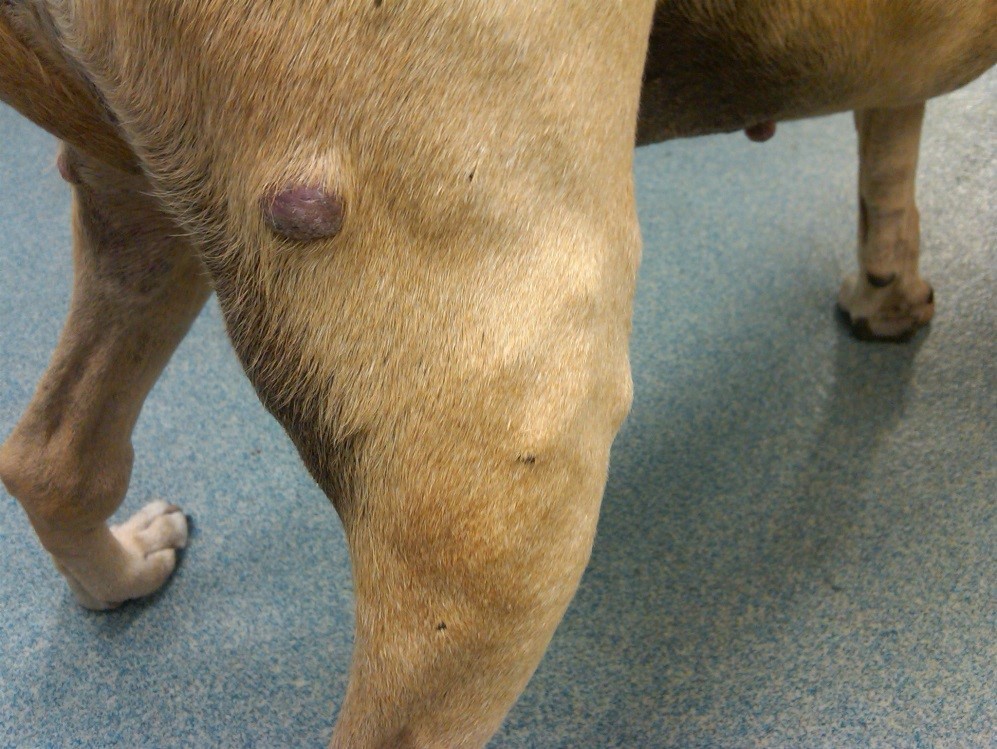Is your dog at risk of Mast Cell Tumors?

Skin cancer is one of the most common cancers our dogs can get – most are benign, but not all.
Many dog parents have tried cannabinoids for these growths (both topically and orally), and some are getting positive results.
We do have a Natural, Whole Plant Extract CBD tincture for Dogs and Cats. It’s here:
Dr Jones’ ULTIMATE CBD for Dogs and Cats


Mast Cell Tumors
One common type of Cancer is Canine Mast Cell Tumors (MCTs). Sounds scary, right? But don’t worry, we’re here to guide you through what MCTs are, how to spot them, and the treatments available, including effective alternative treatments, and a new promising drug called Stelfonta.
What are Mast Cells, and Mast Cell Tumors (MCTs)?
The mast cell has granules of inflammatory biochemicals meant for use against invading parasites. The mast cell has binding sites on its surface for a type of antibody called IgE. When this antibody (IgE) binds to the mast cell, it releases the inflammatory chemicals.
In an allergy, mast cells are ‘confused’ and allergic proteins such as house dust mites cause them to release their granules, resulting in redness, itch, swelling, and other symptoms we associate with allergic reactions.
MCTs are a type of skin cancer in dogs. They originate from mast cells, which are part of their immune system. These cells are supposed to protect our pups, but sometimes they can go rogue and form tumors.
Mast cell tumors are the most common skin tumor in dogs, with between seven and 21 percent of all canine skin tumors being mast cell tumors. Mast cell tumors do not have to involve the skin and can develop internally but most of the time there is skin involvement.
While any dog can develop a mast cell tumor, several breeds have an especially high rate of mast cell tumor development (four to eight times the rate of the general canine population). These breeds are the boxer, the Rhodesian ridgeback, the pug, the Boston terrier, the pit bull terrier, and the Weimaraner. The Shar-pei tends to develop its mast cell tumors at an earlier age and they tend to be especially malignant.
Signs
Some of the common signs:
- Skin Lumps or Bumps: The most common sign of a mast cell tumor in dogs is the presence of a raised, firm, and sometimes ulcerated lump or bump on or just beneath the skin. These lumps can vary in size and may change in size over time.
- Redness and Swelling: MCTs can cause the surrounding skin to become red, inflamed, and swollen. This inflammation is often localized to the area of the tumor.
- Bleeding and Ulceration: Some MCTs can ulcerate (break open), leading to oozing, bleeding, and crusting of the tumor. This can be particularly concerning and should be evaluated by a veterinarian promptly.
- Itching and Scratching: Dogs with MCTs may frequently scratch, lick, or chew at the area where the tumor is located. This can lead to further irritation and discomfort.
- Gastrointestinal Symptoms: In some cases, MCTs can release histamine, which can cause gastrointestinal symptoms such as vomiting, diarrhea, and loss of appetite.
- Change in Behavior: Dogs with MCTs may exhibit changes in behavior, which can include lethargy, depression, or increased restlessness. This may be due to the discomfort and pain associated with the tumor.
- Spreading Tumors: MCTs can spread (metastasize) to other parts of the body, such as lymph nodes, the liver, and the spleen. Symptoms of metastatic disease may include enlarged lymph nodes, difficulty breathing, and abdominal discomfort.
Diagnosis
Diagnosis can often be made with a needle aspirate, which collects some cells of the tumor with a needle, and the cells are examined under the microscope. The granules have distinct staining characteristics leading to their recognition. An actual tissue biopsy, however, is needed to grade the tumor, and grading of the tumor is crucial to determining prognosis
Mast Cell Tumors Grades
- Grade 1 is local growth, unlikely to spread. Surgery generally curative.
- Grade 2 may or may not spread in the body, most of the time surgery can be curative.
- Grade 3 Tumors: This is the worst type of mast cell tumor to have. Grade III tumors account for approximately 25 percent of all mast cell tumors and they behave invasively and aggressively. They will readily spread to the spleen, liver, and bone marrow.
Treatment
Now, let’s talk about treatment. Traditional methods include surgery, radiation, and chemotherapy. Surgery is ideal and for most Grade1/2 tumors it is curative. I had many clients in practice just monitor the dogs with Grade 1 tumors, and we would remove them if they began to grow. Radiation and chemotherapy are options for more advanced cases.
Corticosteroids
Corticosteroids (prednisolone [https://veterinarypartner.vin.com/doc/?id=4951498&pid=19239], dexamethasone [https://veterinarypartner.vin.com/doc/?id=4951415&pid=19239], etc.) seem to be directly toxic to mast cells and can lead to a brief remission even when used alone. Corticosteroids are inexpensive treatments and definitely worth trying should more powerful chemotherapy drugs be considered too expensive or troublesome.
Tigilanol tiglate: Something New
Tigilanol tiglate (Stelfonta) is a new treatment released in the summer of 2020 and is best used for dogs where the mast cell tumor cannot be adequately addressed surgically. Tigilanol tiglate is injected directly into the tumor where it interrupts the tumor blood supply, kills the tumor (up to 80% of tumor cells whereas conventional products kill 40-50% of tumor cells), and promotes healing of the area. The injection leads to a great deal of swelling and bruising, followed by an open wound that heals over several weeks. The manufacturer recommends leaving the healing wound uncovered, which may not be acceptable for some pet families.
Alternative Options for MCT’s
Nettle and Quercetin
These are both ‘natural’ antihistamines with anti-inflammatory qualities. Nettle dose of 100mg/10lbs once-daily. Quercetin dose of 50mg-100mg/10lbs daily.
‘Natural corticosteroid’. I would suggest Licorice Root Extract. Doses of 1/2ml /20lbs twice daily of the tincture.
Dandelion Root Extract
This has been used for MCT’s. 1 teaspoon/10lbs daily of the dried root, simmered in 1/2 cup of water. Give for 14 days and assess response.
Cannabinoids: CBD
Many of the cannabinoids are being used for MCT’s both topically and orally. Standard dose of Dr Jones’ ULTIMATE CBD for Dogs and Cats is 3mg/10lbs daily.
Medicinal Mushrooms
I would consider Chaga as it has been shown to beneficial in decreasing Mast Cell degranulation, along with Turkey Tail as it has been used for many of the Canine Cancers. The standard Turkey Tail dose is 100mg/10lbs daily. Chaga can be given orally as well.
Mast Cell Tumor Chaga Paste
Make a tea with one tablespoon chaga powder with 2 ounces of almost boiling water. Steep, covered, for 30-40 minutes.
To a blender, add:
- Chaga
- Chaga tea
- 1/4 oz castor oil
- 1/2 ounce neem oil into a bullet blender or use a stick blender.
Pulse-blend to make a paste. Add additional chaga powder to achieve paste consistency. Apply to tumor, cover with gauze and leave overnight. Apply this daily. Mixture will last for 2-3 days in the refrigerator. Use vet wrap to keep gauze in place. You can also use chaga paste as a poultice 2-3 times daily.
In conclusion, while the thought of your dog getting an MCT is frightening, remember, knowledge is power. By knowing what to look for and understanding the treatment options available, you can ensure your furry friend gets the best care possible.
P.S. Most Mast Cell Tumors are Grade 1 and can be cured with surgery, or monitored and 1st treated with alternative remedies. If you have a breed at higher risk, then be more aggressive (i.e. boxer, the Rhodesian ridgeback, the pug, the Boston terrier, the pit bull terrier, the Weimaraner and Shar-pei).
P.P.S. If you have a lump on your pet, an arthritic pet, or a dog with cognitive dysfunction, I encourage you to try my CBD for dogs and cats.
It is a whole plant extract meaning it has all the potentially helping cannabinoids that interact with each other to be beneficial, as well as using hemp seed oil as the carrier oil (often this can make it more effective).

I am so happy to have found you. I lost my first dog to Mast Cell Carcinoma and it was so traumatic for both of us.Now I have a joyful three year old golden retriever, I named Gemma. Recently we went through dealing with my pup having eaten two grapes. I took her to the vet four days in a row for treatment, and she was fine. She has been more lethargic the last couple days and I think she might’ve gotten grapes again unfortunately. I found a few grapes on the floor and am worried. A few days ago she was vomiting. She seems more tired today and I saw on a text to a friend that she had vomited three times a day or so ago. I am worried about her. I love her so much!